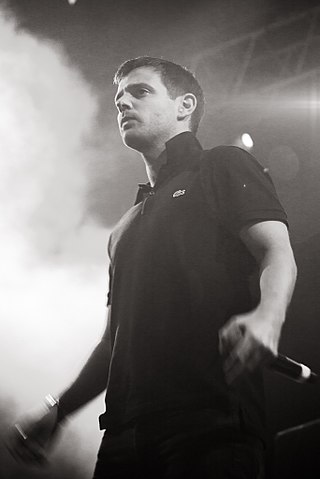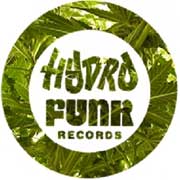Related Research Articles

Articolo 31 is a band from Milan, Italy, formed in 1990 by J-Ax and DJ Jad, combining hip hop, funk, pop and traditional Italian musical forms. They are one of the most popular Italian hip hop groups.

Lorenzo Jerald Patterson, better known by his stage name MC Ren, is an American rapper, songwriter, and record producer from Compton, California. He is the founder and owner of the record label Villain Entertainment.
Digital Underground was an American alternative hip hop group from Oakland, California. Their personnel changed and rotated with each album and tour.

Acid jazz is a music genre that combines elements of funk, soul, and hip hop, as well as jazz and disco. Acid jazz originated in clubs in London during the 1980s with the rare groove movement and spread to the United States, Japan, Eastern Europe, and Brazil. Acts included The Brand New Heavies, D'Influence, Incognito, Us3, and Jamiroquai from the UK and Buckshot LeFonque and Digable Planets from the U.S. The rise of electronic club music in the middle to late 1990s led to a decline in interest, and in the twenty-first century, the movement became indistinct as a genre. Many acts that might have been defined as acid jazz are seen as jazz-funk, neo soul, or jazz rap.

Tha Dogg Pound is an American hip hop duo made up of rappers Kurupt and Daz Dillinger. They were signed to Death Row Records in their early careers and were key to the label's success.
Australian hip hop traces its origins to the early 1980s and is largely inspired by hip hop and other urban musical genres from the United States. As the form matured, Australian hip hop has become a commercially viable style of music that is no longer restricted to the creative underground, with artists such as The Kid Laroi, Manu Crooks, Onefour, Iggy Azalea, Hilltop Hoods, Bliss n Eso and Youngn Lipz, having achieved notable fame. Australian hip hop is still primarily released through independent record labels, which are often owned and operated by the artists themselves. Despite its genesis as an offshoot of American hip-hop, Australian hip hop has developed a distinct personality that reflects its evolution as an Australian musical style.

David Marvin Blake, better known by his stage names DJ Quik or Da Quiksta, is an American rapper and producer, known for his production in the G-funk style of West Coast hip-hop. Blake has collaborated with Snoop Dogg, Kurupt, Tupac, Chingy, R. Kelly and Shaquille O'Neal, among others. Blake's stage name reflects his ability to produce songs in a short period of time. Some of his top songs include "Dollaz + Sense", "Tonite", "Born and Raised in Compton" and "Jus Lyke Compton".
UK rap, also known as British hip hop or UK hip hop, is a genre of music, and a culture that covers a variety of styles of hip hop music made in the United Kingdom. It is generally classified as one of a number of styles of R&B/Hip-Hop. British hip hop can also be referred to as Brit-hop, a term coined and popularised mainly by British Vogue magazine and the BBC. British hip hop was originally influenced by the dub/toasting introduced to the United Kingdom by Jamaican migrants in the 1950s–70s, who eventually developed uniquely influenced rapping in order to match the rhythm of the ever-increasing pace and aggression of Jamaican-influenced dub in the UK. Toasting and soundsystem cultures were also influential in genres outside of hip hop that still included rapping – such as grime, jungle, and UK garage.
The Herbaliser is an English jazz hip hop group formed by Jake Wherry and Ollie Teeba in London, England during the early 1990s. Although currently releasing on their own label and having previously been signed to !K7 Records, they were one of the best-known acts from the Ninja Tune independent record label. They have released 12 albums, including two DJ mixes: one for Ninja Tune's Solid Steel series and the other for Fabric's Live Mix series. The Herbaliser's album Same As It Never Was was their first release on !K7 Records. Their latest album Bring Out The Sound was released in 2018, on the BBE label.

Whodini is an American hip hop group that was formed in 1982. The Brooklyn, New York-based trio consisted of vocalist and main lyricist Jalil Hutchins; co-vocalist John Fletcher, a.k.a. Ecstasy ; and turntable artist DJ Drew Carter, a.k.a. Grandmaster Dee.

Kendrick Jeru Davis, known as Jeru the Damaja, is an American rapper and record producer. He is known for his 1993 single "Come Clean" from his debut album, The Sun Rises in the East, ranked as one of the 100 greatest hip-hop albums of all time by the editors of About.com. He has worked extensively with Guru and DJ Premier of Gang Starr, whom he has known since he was in high school.
London Posse was a British hip hop group. According to The Daily Telegraph, they "finally gave British rap an identity of its own." London Posse member Bionic led the charge for UK and worldwide artists to use their own accents and languages rather than copy Americans and was the architect behind their biggest hit "Money Mad" introducing 'road style' to UK hip hop and mixing it with ragga/dancehall.
Hardnoise were an early British hip hop group. Hardnoise, along with early label-mates Hijack, was influential in establishing the UK hardcore sound. The group only released a handful of singles, before reforming with a changed membership as Son of Noise.
European hip hop is hip hop music created by European musicians. Hip hop is a style of music developed by African American and Caribbean communities in the United States during the mid-1970s, and became a large part of modern pop culture during the 1980s. Due to this success, it has gained worldwide popularity, especially in Europe where many diverse and unique styles of hip hop have been created. This diversity is especially apparent in the forms of hip hop music and culture emanating from settler communities from Europe's former colonies and peripheries.

Michael Geoffrey Skinner is an English rapper, singer-songwriter, musician, and record producer. Best known for the music project the Streets, Skinner has also released music as a solo artist, as part of the D.O.T. with frequent collaborator Rob Harvey, and under the pseudonym The Darker the Shadow the Brighter the Light.

Hydrofunk Records is an independent Australian hip hop record label that represents a number of Australian acts including the Resin Dogs and Def Wish Cast.
Urban Species is a British hip-hop band, best known for several hit singles during the 1990s. The band's music draws on a diverse range of influences and combines live playing with samples and programming, resulting in an organic sound that has sometimes been compared to a British version of Arrested Development. The band's music is frequently associated with the acid jazz movement of the mid-1990s.

Frederick Schmid, better known by his stage name Freddy Fresh, is an American DJ, musician, and electronic music producer. Fresh has recorded for over 100 independent record labels, including major labels Sony UK, Virgin, BMG UK, and Harthouse Germany. He is also founder of the record labels Howlin' Records, Electric Music Foundation, and Analog.
Gutter Snypes are a British hip hop group who formed in 1993. The group was composed of Cel One, Sigher and Prime Cuts. Previously the Cel One had recorded under the name Most Dominant for the Kold Sweat Records label, with DJ First Rate and DJ Renegade. Prior to this, Cel One and First Rate had been part of the First Down Crew in Kent.

Black Sheep is an American hip hop duo from Queens, New York, United States, composed of Andres "Dres" Vargas Titus and William "Mista Lawnge" McLean. The duo was from New York but met as teenagers in Sanford, North Carolina, where both of their families relocated. The group was part of the Native Tongues collective, which included the Jungle Brothers, A Tribe Called Quest, and De La Soul. After getting together in 1989, Black Sheep debuted in 1991 with the hit song "Flavor of the Month" and later released its first album, A Wolf in Sheep's Clothing, which gained them praise and recognition in the hip-hop community for the album's unique rhythms and intelligent, often humorous lyrics. After six years together, Black Sheep disbanded in 1995, citing creative differences.
References
- 1 2 Heroes Of UK Hip Hop, undated. The Brotherhood.
- ↑ UK Hip Hop: The Story. The Underground Years: 1990–1995.
- 1 2 "The Brotherhood music, videos, stats, and photos". Last.fm.
- 1 2 3 Clash Music Archived 29 May 2014 at the Wayback Machine . 2009. Personality Clash: Headman vs. Trevor Jackson: Trevor Jackson On Underdog, The Brotherhood and Bite It! Days.
- 1 2 3 4 Kulkarni, Neil, "Dead Dead ‘Hood", Melody Maker , 3 February 1996, p. 46.
- ↑ Labels And Studios Of The World. British Hip Hop – Part Four.
- ↑ "Pete Parsons Interview part 1 – Blog To The Oldskool". Blogtotheoldskool.com.
- ↑ Jones, R, 1993, 'Brothers in the Hood'. Echoes. 21 August.
- ↑ Echoes Hip Hop Chart. Echoes. May 1993.
- ↑ Adam Sutherland. Undated. Brotherhood. Straight No Chaser, p. 6.
- ↑ Cynthia Rose, "Old Religion; New Rappers", The Independent, 1993.
- ↑ Paul Rogers. 1993. Ruffneck Bizniz: Paul Roger’s Rap Report. Blues & Soul. 593, p. 41.
- ↑ Michael Leonard. 1993, p. 22.
- 1 2 Dance Update. Record Mirror, 2 October 1993.
- ↑ Untitled. Rap Boom, 1993.
- ↑ Ross Jones, "ARP Fundamentals", Echoes, 25 December 1993.
- ↑ Max & Dave. Untitled. Blues & Soul, 1993.
- ↑ Paul Mardle. 1994. Brothers Up In Arms.
- ↑ "DJ Crystl music, videos, stats, and photos". Last.fm.
- 1 2 "D To The K* - Hard But Live / Ease Up Your Mind". Discogs.
- ↑ "Various - Hard Core 1". Discogs.
- 1 2 Angus Batey, "Sibling The Noise", NME, 4 September 1993.
- 1 2 JDC, The Brotherhood: "Wayz Of The Wize" (Bite It), Touch. October 1992.
- ↑ Unknown. 1992 Brotherhood Wayzof The Wize/ Hit The Funk (Bite It).Straight No Chaser. Autumn.
- ↑ Hip Hop Chart. 1992. The Brotherhood: 'Wayz Of The Wize' (Bite It).
- ↑ Unknown. 1992. The Hip Hop Column.
- ↑ DJ Ruffcut. Hip Hop Chart, NME, 28 November 1992.
- ↑ Unknown. 1993. Hip/Hop Ragga: Recommended. Mixmag.
- ↑ DJ Ruffcut. The Brotherhood XXII. Mixmag, 18 August 1993.
- ↑ Ross Jones. Brothers In The Hood. Echoes, 21 August 1993.
- ↑ James Lavelle, "Smoke A Spliff But I Won’t Sniff (Bite It!)". Straight No Chaser, 1993.
- ↑ Ross Jones. The Brotherhood XXIII EP [Bite It!]. Echoes']. 14 August 1993.
- ↑ Adam Sutherland. 1993. The Brotherhood XXIII EP (Bite It!). Straight No Chaser.
- ↑ The Ruf. Hip Hop N' Rap Review. Represent Magazine, August/September 1994.
- 1 2 "Mr Spoon. 1996. Classic Interview: The Brotherhood". Ukhh.com.
- 1 2 3 "The Brotherhood Alphabetical Response". YouTube.
- 1 2 3 Kevin Braddock. 1996. The Brotherhood. Elementalz. NME.
- ↑ Neil Braddock. 1996. Punk Funk. NME.
- 1 2 Sonia Poulton. 1995. Enter The Brotherhood. Spectator.
- ↑ "The Brotherhood. 2010. Sleeve Scans". Myspace.com.
- ↑ The Brotherhood. One Shot. Virgin Records. YouTube
- ↑ [ dead link ]
- ↑ "Underground United | Underground United Vol. 3 2xLP | Releases". undergroundunited.de. Retrieved 9 January 2017.
- ↑ "Various - The British Underground E.P." Discogs.
- ↑ "Loading..." Olasunbekons.com.